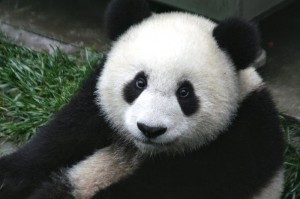Giant Panda Bear
 The giant panda bear is one of the few bears, along with other panda species that does not belong to the Ursus (Bear) family. Instead they belongs to the Ailurpoda family, with the exception of the Red Panda, which belongs to Ailuridae; yet are classified as bears. The bear that is closest related to the giant panda is thought to be the spectacled bear.
The giant panda bear is one of the few bears, along with other panda species that does not belong to the Ursus (Bear) family. Instead they belongs to the Ailurpoda family, with the exception of the Red Panda, which belongs to Ailuridae; yet are classified as bears. The bear that is closest related to the giant panda is thought to be the spectacled bear.
The scientific name for the giant panda is Ailuropoda melanoleuca, which means ‘cat-foot black-and-white’.
All bears are carnivorous, however depending on the species, some eat vegetation as well. The panda bear is possibly one of the most herbivorous bears in the world. Indeed the giant panda bear’s diet is said to be 99% bamboo. The remaining 1% is made up of fish, yam, shrub leaves, honey, bananas and oranges if these are available.
Giant Pandas can mainly be found in central china.
Unfortunately giant pandas are classed as endangered. In fact it is believed that there is only 3,000 (at the most) giant pandas left in the wild. It is thought that these bears are endangered due to excessive habitat loss and their very low birth rate. It can take up to 8 years of age before a giant panda reaches sexual maturity, and many will only be capable of breeding up to 20 years of age. It appears that giant pandas don’t breed any more in the wild than they do in captivity (which isn’t a lot). A female will only be in season for two to three days a year, usually between March and May, so this means there is little time for a successful mating to take place. Many zoos and researchers have set up conservation and breeding programmes for giant pandas to try to rebuild the number of wild giant pandas.
Did you know that adult giant panda bears can be almost 5 feet long? Its tail can be up to 6 inches long meaning that the giant panda species has the second longest tail in the bear family, (Sloth bears have the longest tails).
In captivity Giant panda bears can live up to 30 years.
There are currently two known sub-species of the giant panda, the Ailuropoda melanoleuca melanoleuca and the Ailuropoda melanoleuca qinlingensis (Qinling Panda).
 May 30, 2010
·
May 30, 2010
·  Maddia (Admin) ·
Maddia (Admin) ·  2 Comments
2 Comments
 Tags: Animals, Bears, endangered animals, panda bears, rare animals, wild animals · Posted in: Panda Bear Species
Tags: Animals, Bears, endangered animals, panda bears, rare animals, wild animals · Posted in: Panda Bear Species



2 Responses
I love giant pandas!
Wow, that’s interesting. I would search on Google to find other relevant information. Actually, I came across your blog on Google Blog Search. I’m going to add your RSS feed to my reader. Continue posting please!